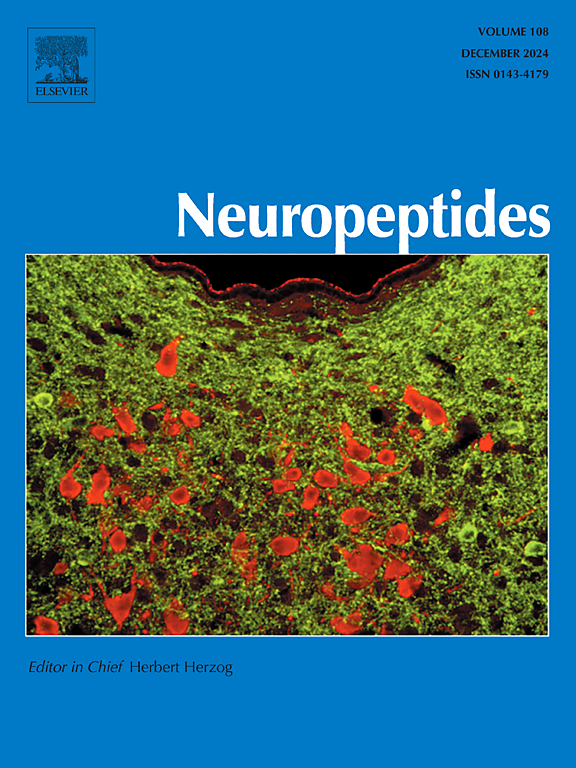星形胶质细胞葡萄糖-6-磷酸化酶- β调节腹内侧下丘脑核葡萄糖反调节神经传递和全身激素谱
IF 2.7
3区 医学
Q3 ENDOCRINOLOGY & METABOLISM
引用次数: 0
摘要
脑星形胶质细胞在糖原分解或糖异生结束时通过葡萄糖-6-磷酸酶-β (Glc-6-Pase-β)水解作用产生游离葡萄糖。星形胶质细胞形成下丘脑腹内侧核(VMN),通过提供乳酸调控葡萄糖,但星形胶质细胞内源性葡萄糖产生的可能影响尚不清楚。目前的研究研究了在体内VMN星形胶质细胞Glc-6-Pase-β基因敲低后,VMN神经元反调节神经递质标记蛋白表达和反调节激素分泌的低血糖和低血糖模式。基因沉默导致VMN星形胶质细胞Glc-6-Pase-β蛋白表达降低,组织糖原和葡萄糖含量降低。低血糖抑制(后内侧VMN;VMNdm)或增强(腹侧VMN;糖原的VMNvl分别涉及Glc-6-Pase-β非依赖性和依赖性机制。siRNA预处理逆转了低血糖对VMNdm葡萄糖水平的下调,并增强了上调的VMNvl葡萄糖积累。Glc-6-Pase-β基因敲低相应抑制或增强谷氨酸脱羧酶65/67 (GAD)和神经元一氧化氮合酶(nNOS)的基线表达,这是抑制或增强神经化学物质γ-氨基丁酸和一氧化氮的蛋白标志物。Glc-6-Pase-β siRNA预处理不改变VMN GAD蛋白的降糖抑制,但逆转(VMNdm)或扩增(VMNvl) nNOS上调。VMN Glc-6-Pase-β基因沉默减轻了皮质酮和生长激素分泌的低血糖模式,并增强了胰高血糖素的释放。综上所述,数据提供了VMN Glc-6-Pase-β活性影响葡萄糖反调节的独特证据。结果证明星形胶质细胞Glc-6-Pase-β控制VMN葡萄糖和糖原积累以及VMN神经元反调节神经传递。需要进一步的研究来确定星形胶质细胞葡萄糖代谢中Glc-6-Pase-β介导的调节,其影响脑葡萄糖代谢回路中VMN gab能和/或氮能信号。本文章由计算机程序翻译,如有差异,请以英文原文为准。
Astrocyte Glucose-6-phosphorylase-Beta regulates ventromedial hypothalamic nucleus glucose counterregulatory neurotransmission and systemic hormone profiles
Brain astrocytes generate free glucose at the conclusion of glycogenolysis or gluconeogenesis by glucose-6-phosphatase-beta (Glc-6-Pase-β) hydrolytic action. Astrocytes shape ventromedial hypothalamic nucleus (VMN) control of glucose counterregulation via lactate provision, yet possible effects of astrocyte endogenous glucose production are unknown. Current research investigated eu- and hypoglycemic patterns of VMN neuron counterregulatory neurotransmitter marker protein expression and counterregulatory hormone secretion following in vivo VMN astrocyte Glc-6-Pase-β gene-knockdown. Gene-silencing caused reductions in VMN astrocyte Glc-6-Pase-β protein expression and tissue glycogen and glucose content. Hypoglycemic suppression (dorsomedial VMN; VMNdm) or augmentation (ventrolateral VMN; VMNvl) of glycogen involves Glc-6-Pase-β –independent versus -dependent mechanisms, respectively. siRNA pretreatment reversed hypoglycemic down-regulation of VMNdm glucose levels and intensified up-regulated VMNvl glucose accumulation. Glc-6-Pase-β gene-knockdown correspondingly suppressed or enhanced baseline expression of glutamate decarboxylase65/67 (GAD) and neuronal nitric oxide synthase (nNOS), protein markers for the counterregulation-inhibiting or -enhancing neurochemicals γ-aminobutyric acid and nitric oxide. Glc-6-Pase-β siRNA pretreatment did not alter hypoglycemic suppression of VMN GAD protein but reversed (VMNdm) or amplified (VMNvl) nNOS up-regulation. VMN Glc-6-Pase-β gene-silencing attenuated hypoglycemic patterns of corticosterone and growth hormone secretion and enhanced glucagon release. In summary, data provide unique evidence that VMN Glc-6-Pase-β activity affects glucose counterregulation. Outcomes document astrocyte Glc-6-Pase-β control of VMN glucose and glycogen accumulation as well as VMN neuron counterregulatory neurotransmission. Further research is warranted to identify Glc-6-Pase-β – mediated adjustments in astrocyte glucose metabolism that affect VMN GABAergic and/or nitrergic signaling within the brain glucostatic circuitry.
求助全文
通过发布文献求助,成功后即可免费获取论文全文。
去求助
来源期刊

Neuropeptides
医学-内分泌学与代谢
CiteScore
5.40
自引率
6.90%
发文量
55
审稿时长
>12 weeks
期刊介绍:
The aim of Neuropeptides is the rapid publication of original research and review articles, dealing with the structure, distribution, actions and functions of peptides in the central and peripheral nervous systems. The explosion of research activity in this field has led to the identification of numerous naturally occurring endogenous peptides which act as neurotransmitters, neuromodulators, or trophic factors, to mediate nervous system functions. Increasing numbers of non-peptide ligands of neuropeptide receptors have been developed, which act as agonists or antagonists in peptidergic systems.
The journal provides a unique opportunity of integrating the many disciplines involved in all neuropeptide research. The journal publishes articles on all aspects of the neuropeptide field, with particular emphasis on gene regulation of peptide expression, peptide receptor subtypes, transgenic and knockout mice with mutations in genes for neuropeptides and peptide receptors, neuroanatomy, physiology, behaviour, neurotrophic factors, preclinical drug evaluation, clinical studies, and clinical trials.
 求助内容:
求助内容: 应助结果提醒方式:
应助结果提醒方式:


